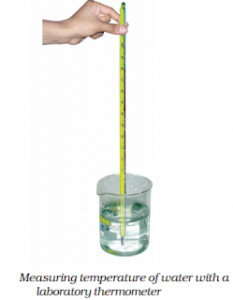Notes For All Chapters Science Class 7
Study Material and Notes of Ch 3 Heat Class 7th Science
Hot and Cold
→ The measure of degree of hotness or coldness of a substance is called its temperature.
→ The device that is used to measure the temperature of a substance is called thermometer.
Measuring Temperature
→ Thermometers are of two types:
(i) Clinical thermometer: Used for measuring temperature of human body.
(ii) Laboratory thermometer: Used for measuring temperature of common objects.
Reading a thermometer
→ The temperature range of clinical thermometer is 35ºC to 42°C and that of laboratory thermometer is -10ºC to 110ºC. The unit for temperature is °C.
Step 1: Note the temperature difference indicated between the two bigger marks.
Step 2: Note down the number of divisions between these marks. If there are five divisions between them the, one small division can read 1/5 = 0.2°C
Step 3: Wash the thermometer with an antiseptic solution and give it a few jerks while holding firmly. Ensure that the level of mercury falls below 35°C.
Step 4: Now place the bulb of the thermometer under your tongue. Take the thermometer out after one minute and note the reading. This is your body temperature. The temperature should always be stated with its unit, °C.
→ The normal temperature of human body is 37°C.
→ The two most commonly used scales in which temperature is read are the Celsius scale and Fahrenheit scale.
Precaution for clinical thermometer
→ Do not use a clinical thermometer for measuring the temperature of any object other than the human body.
→ Also avoid keeping the thermometer in the sun or near a flame. It may break.
Precaution for laboratory thermometer
→ In addition to the precautions needed while reading a clinical thermometer, the laboratory thermometer should be kept upright not tilted.
→ Bulb should be surrounded from all sides by the substance of which the temperature is to be measured. The bulb should not touch the surface of the container.
Transfer of Heat
• Conduction: The transfer of heat in solids usually takes place by this method. Substances that allow heat to pass through them quite easily are called conductors and those that do not, are called insulators.
→ The substances that allow heat to pass through them are called conductors of heat. Iron, copper, and aluminium are examples of conductors.
→ The substances that do not allow heat to pass through them are called poor conductors of heat or insulators. Plastic and wood are examples of insulators.
• Convection: The transfer of heat in liquids and gases takes place by convection. Land breeze and sea breeze are a result of unequal heating of air present over land and sea by the sun.
• Radiation: Transfer of heat by radiation requires no medium. Heating of earth by sun is an
example of heat transfer by radiation.
Sea Breeze
→ The people living in the coastal areas experience an interesting phenomenon. During the day, the land gets heated faster than the water. The air over the land becomes hotter and rises up.
→ The cooler air from the sea rushes in towards the land to take its place. The warm air from the land moves towards the sea to complete the cycle. The air from the sea is called the sea breeze.
Land Breeze
→ At night it is exactly the reverse. The water cools down more slowly than the land. So, the cool air from the land moves towards the sea. This is called the land breeze.
Kinds of clothes we wear in winter and Summer
→ Dark surfaces absorb more heat and, therefore, we feel comfortable with dark coloured clothes in the winter.
→ Light coloured clothes reflect most of the heat that falls on them and, therefore, we feel more comfortable wearing them in the summer.
→ In the winter, we use woollen clothes. Wool is a poor conductor of heat. The air get trapped in between the wool fibres. This air prevents the flow of heat from our body to the cold surroundings which make us feel warm.
NCERT Solutions of Heat Class 7





This is not the normal notes